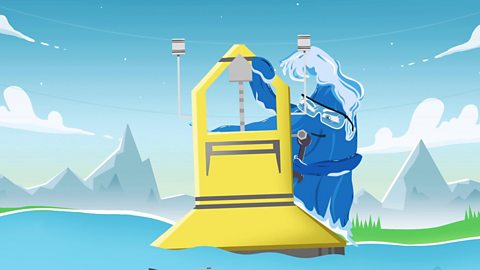What is hydroelectric power?
Hydroelectric energy is a type of renewable Something that does not run out when used. energy that uses the power of moving water (hydropower) to generate electricity.
In this article you can learn:
- What hydroelectricity is
- What happens inside a hydroelectric dam
- How energy is transferred from one type to another
- What the advantage and disadvantages of hydroelectric energy are
This resource is suitable for energy and sustainability topics for primary school learners.
Video - Hydroelectric power
In this video, learn about hydroelectricity and how hydroelectric power works.
Meet Hydro-electricity.
He's a type of renewable energy.
How you doing, Hydro?
Look at him…
He's right at home in the Highlands.
You see, to start making hydro-electric power you need two things.
Hills and a natural source of water.
And Scotland has its fair share of both.
This is Torr Achilty power station on Loch Achonachie, in the north of Scotland.
It's a hydro-dam. Let's have a look at how it works.
Hydro, could you possibly… Yep. Thanks.
OK, so the dam blocks the water, which holds potential energy. Pressure builds up and, when released, the water rushes down through a tunnel, called a pen-stock, converting potential energy to kinetic energy.
The kinetic energy then turns the turbines really quickly.
And the turbines, along with the generator and transformer, produce electricity.
Losing just a little bit of wasted energy along the way through heat and sound.
This electricity then flows all the way from the dam to your home.
So you can make your toast in the morning!
But let's rewind a second.
What makes hydro-electric power renewable?
Well, the water-cycle is constantly renewed by the sun.
Water evaporates, creating clouds, which rain on the beautiful Scottish hills. Filling our rivers and streams and flowing back into our hydroelectric dam.
But old Hydro has a few secrets he'd rather you didn't know.
Don't you, Hydro?
Firstly, he's a bit older than he looks… The ancient Greeks made water wheels to power their grain mills two thousand years ago!
And secondly, he's not quite as environmentally friendly as you might think.
To create a dam you need to block a river and flood a glen, which destroys local animal and plant habitats.
So there he is - old man Hydro.
He's renewable and he's plentiful.
Hydro-electric power is one of the biggest sources of renewable energy in Scotland.
On the downside he can cause damage to the local environment.
But then, nobody's perfect. Are they, Hydro?
Why is hydroelectricity useful?
In 2020, hydropower generated 58% of the world’s renewable Something that does not run out when used. electricity. Renewable types of energy are better for the global climate The usual conditions of weather (temperature, wind, rainfall etc.) on Earth over a long period of time. as they don't run out or produce harmful emissions that damage the .
Hydroelectricity is Scotland’s second largest renewable Something that does not run out when used. energy type (after wind) and is used to produce electricity that can power homes. Scotland generates 85% of the UK’s hydroelectric power.
How do hydroelectric dams work?
Hydroelectricity is generated at a hydroelectric dam.
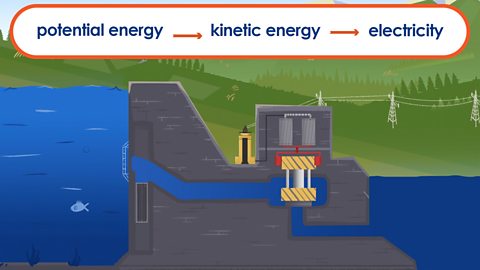
Image caption, Water stored at a hydroelectric dam has potential energy. When it runs through the dam this turns to kinetic energy. The kinetic energy of the moving water is used to generate electricity.
Image caption, Water flows down through the penstock. It turns the blades of turbines as it passes through them. The spinning turbines turn generators that create electricity. The electricity passes through transformers so it can travel long distances efficiently.
Image caption, The water cycle returns water to the dam, making hydroelectric power renewable and reliable.
1 of 3
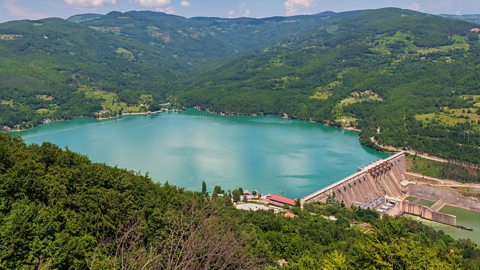
A dam’s job is to block the flow of a water source, such as a river, creating a large reservoir of water. As the water has nowhere to go, a large amount of water pressure builds up. This generates potential energyEnergy stored by an object because of its relationship with other objects or forces. For example, if you pull back the bowstring on a bow and arrow, it has potential energy to snap forward once it is let go. as the water, if released, will rush down through the dam.


When it is released, the water travels from the reservoir through a tunnel in the dam called the penstockA large pipe or tunnel that carries water from the reservoir down to the turbines in the hydroelectric power station..
Because the water is now moving, it changes from having potential energy to kinetic energyEnergy that an object possesses because of its movement. A ball being thrown through the air has kinetic energy because it is moving. When water moves this is also an example of kinetic energy. . This kinetic energy turns the turbineA turbine is a machine that turns the movement of liquid or gas into energy that can be used. In a simple turbine water or air push against turbine blades and spin them round. The spinning blades turn a long pole called a shaft. The shaft can then turn other pieces of machinery, such as a generator that is used to produce electricity. quickly, which then turn the generatorA machine that is used to make electricity. When the generator head is turned, this energy is converted to electrical energy..

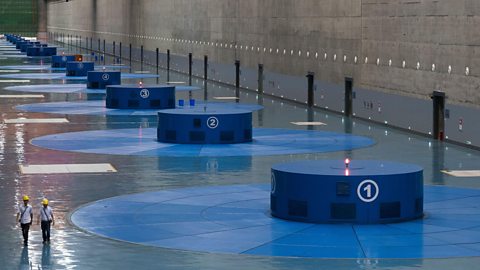
When the generators turn, they convert the kinetic energy into electrical energy.
The transformerAn electrical device that is used to transfer electrical energy from one electrical circuit to another. then adjust the electricity's voltage so that it can travel long distances through power lines without losing lots of energy. Other transformers then reduce the voltage to a safer level before the electricity enters our homes, schools or workplaces.

Hydroelectric dam examples
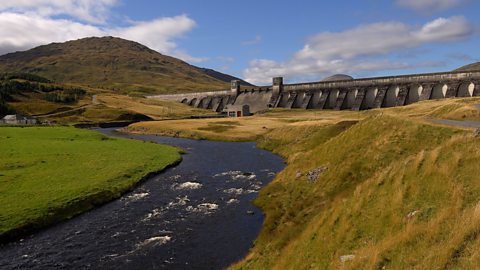
Image caption, Lubreoch Dam and Power Station in Perthshire, Scotland
Lubreoch Dam next to Loch Lyon is one of many dams generating hydroelectric power in Scotland. ( David Paterson / Alamy Stock Photo)
Image caption, The Three Gorges dam and power station, China
The Three Gorges hydroelectric dam in China is the world’s biggest hydroelectric power station. China is the world’s largest producer of hydroelectricity. (GANG ZHAO / Alamy Stock Photo)
Image caption, Dam construction along the Amazon River, Brazil
Brazil is using the power of the Amazon River to generate hydroelectricity for the country. Areas of rainforest are being destroyed and indigenous people are being moved from their land. (REUTERS / Alamy Stock Photo)
1 of 3
The advantages and disadvantages of hydroelectricity
Advantages
Hydroelectric energy is renewable. Find out what renewable energy is here: What is renewable and non-renewable energy?
It is a reliable energy source. Unlike wind and the sun, we know that stored water can provide a 24/7 source of kinetic energy.
Once built, it does not produce harmful emissions. This means it does not contribute to the production of greenhouse gases and climate change.
Disadvantages
To create a hydroelectric dam, you need to flood an area of land, which damages local environment and animal habitats.
In some cases, people may be forced to move home if they live on land that is to be flooded or developed due to the construction of a hydroelectric power plant.
Building hydroelectric dams is expensive and uses lots of concrete, which releases greenhouse gases when it is made.

Key words about hydroelectric energy
Sorry, something went wrongCheck your connection, refresh the page and try again. – Something that does not run out when used.
Sorry, something went wrongCheck your connection, refresh the page and try again. – The usual conditions of weather (temperature, wind, rainfall etc.) on Earth over a long period of time.
Sorry, something went wrongCheck your connection, refresh the page and try again. – Our physical surroundings on Earth, including all living and non-living things.
Sorry, something went wrongCheck your connection, refresh the page and try again. – Electricity that is produced by the movement of water.
Sorry, something went wrongCheck your connection, refresh the page and try again. – A large body of water, often man made, that has been created by stopping the natural flow of water.
Sorry, something went wrongCheck your connection, refresh the page and try again. – A large pipe or tunnel that carries water from the reservoir down to the turbines in the hydro-electric power station.
Sorry, something went wrongCheck your connection, refresh the page and try again. – A simple turbine has a shaft and blades that turn movement in to energy. Usually water or air push the blades and turn the shaft. Turbines are used to turn the generator.
Sorry, something went wrongCheck your connection, refresh the page and try again. – A machine that is used to make electricity. When the generator head is turned, this energy is converted to electrical energy.
Sorry, something went wrongCheck your connection, refresh the page and try again. – An electrical device that is used to transfer electrical energy from one electrical circuit to another.
Test your knowledge
Quiz
Challenge

Draw a diagram of the inside of a hydroelectric dam
Label the working parts using information from the video and key words list.
More on Energy sources and sustainability
Find out more by working through a topic
- count9 of 14
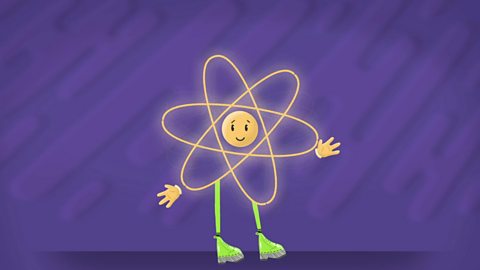
- count10 of 14

- count11 of 14
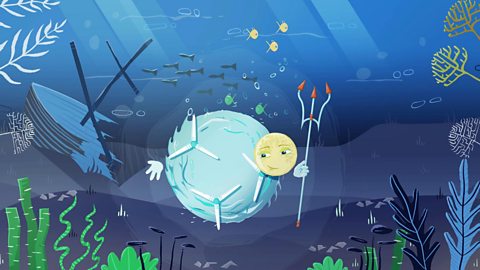
- count12 of 14
